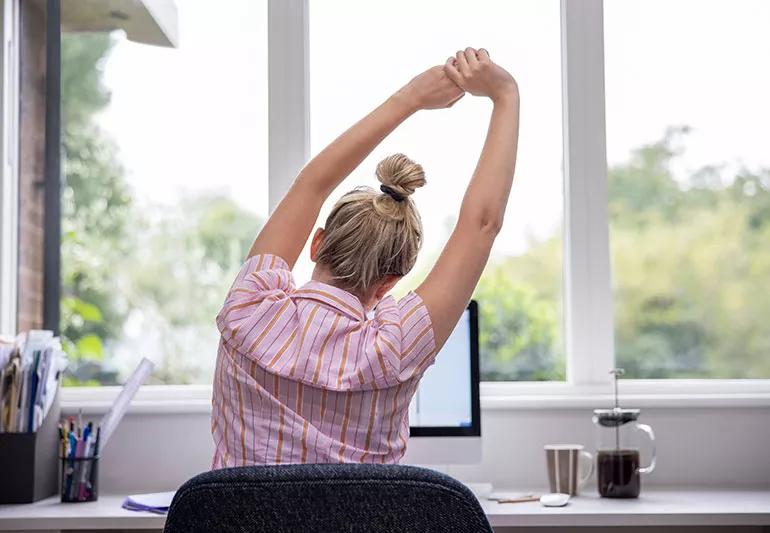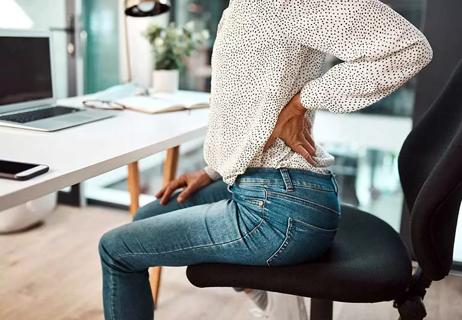5 stretches and exercises to relieve pressure on your spine

Tightness grips your back as you sit at your desk plowing through another batch of emails. The feeling doesn’t hurt — but it’s not all sorts of fabulous, either. So you twist your torso just a little bit seeking a reprieve.
Advertisement
Cleveland Clinic is a non-profit academic medical center. Advertising on our site helps support our mission. We do not endorse non-Cleveland Clinic products or services. Policy
That’s when you hear it: Crack!
Instant relief follows that oh-so-satisfying sound. That felt really good, right? But here’s the question: Is cracking your back actually good for you? Let’s get the answer from chiropractor Andrew Bang, DC.
First things first: How is that cracking sound actually made? The answer requires a little refresher course on human anatomy.
Let’s start with the spine, which snakes down the middle of your back. It combines with 33 interlocking bones called vertebrae to serve as your body’s primary support column. (Fast fact: Your spine supports about half of your body weight.)
This intricate system of bones is a marvel of engineering, combining strength and flexibility to help you sit, stand, walk, twist and bend.
Slippery connective tissue fills the joints between the vertebrae. This cartilage provides the flexibility that lets your body move like one of those inflatable air dancers outside car dealerships.
Those facet joints also speak out from time to time… especially when they’re fatigued. Overuse of a body joint leads to a buildup of gases and pressure inside it.
“Your joints don’t do well with pressure on them,” says Dr. Bang.
So they crack under that pressure. (Loudly, at times.)
Advertisement
The sound comes from that built-up gas escaping the joint when it’s stretched or manipulated. You also may hear popping or snapping noises from tendons and muscles “flicking” over this and that.
The answer is yes if you do it yourself, but with a warning label. “You move and you might crack your back without doing much of anything,” explains Dr. Bang. “It’s natural and it happens to everyone. In that regard, it’s not bad for you.”
The issue, however, is frequency. Gently cracking your back once every few days — or even once a day — isn’t necessarily a problem.
But if you’re making your back go snap, crackle and pop every few hours to relieve overburdened joints, that’s a sign of a repetitive stress issue that needs to be addressed, says Dr. Bang.
“When you start doing it multiple times a day, you’ve got to realize your body is trying to tell you something,” notes Dr. Bang. “You need to make some changes to get the pressure off.”
In today’s tech-driven world, sitting at a computer for hours on end can lead to muscle fatigue and joint stiffness in your back. Some simple changes can reduce the stress and strain on your body.
For example:
“The goal is to create some variety,” says Dr. Bang. “You wouldn’t go to the gym and only do bicep curls, right? It’s the same idea here. You have to switch things up and use different muscles.”
Gentle stretching also may help relieve tension on your back — or even safely make it crack. Here are a handful of seated, standing and on-the-floor stretches and exercises to try.
What this helps: The movement builds range of motion in the spine while also working muscles in your back. The stretch also benefits your neck, hips and even shoulders.
What this helps: The stretch can help release tension in your lower back to address sciatic nerve pain.
Advertisement
What this helps: The stretch targets muscles in your upper back and shoulders.
What this helps: The movement builds flexibility and strength for your lower back.
What this helps: Foam rolling can help release muscle tension while improving flexibility and range of motion.
Looking for more ways to strengthen your back? An orthopaedic clinical specialist suggests four exercises to build core muscles that can help protect your spine. Yoga poses can offer some real benefits, too.
Only if they’re a professional, advises Dr. Bang. “Physical therapists, chiropractors, osteopathic physicians — they’re all trained on how to properly do manipulation in a way that’s safe for you,” he says.
Advertisement
What isn’t safe is letting a well-intentioned buddy jerk your spine until it cracks. Improper technique and exerting too much force and pressure can lead to herniated discs, muscle strains or even broken ribs.
“Injuries happen with high-speed directional changes,” says Dr. Bang. “You don’t want someone to bear hug you to the breaking point.”
Cracking your own back carries far less risk because you’re in control of the crack-a-lacking movement. Basically, you can feel your limits — which should prevent you from pushing to the point of injury.
“If you’re cracking your back once a day, it’s not a big deal,” says Dr. Bang. “But if it becomes more than that, take the time to understand why. Don’t just let it become a habit.”
Advertisement
Learn more about our editorial process.
Advertisement

Hanging upside down for any length of time may decompress the tension in your spine

Drinking alcohol can cause nerve pain, dehydration and weight gain, which can all lead to back pain

Your sleep position, immobility, mattress and underlying conditions can all cause morning back pain

Rest may be all you need to get rid of running-related lower back pain

It’s always a good idea to let a healthcare provider know about any back pain you’re experiencing, especially if it results from trauma or persists longer than three months

From physical and biofeedback therapy to nerve ablations and blocks, there are many nonsurgical options for managing back pain

Rest, physical therapy, acupuncture and nerve blocks are just a few ways to find relief

Get moving, use cold packs, and try yoga and stretches to ease back pain

The best parenting style balances enforcing rules and showing plenty of love

Tips include cutting back on sugar, focusing on exercise and managing stress

It can be harder to let go when you’ve invested time, energy and emotions — but it might be the healthier choice long term